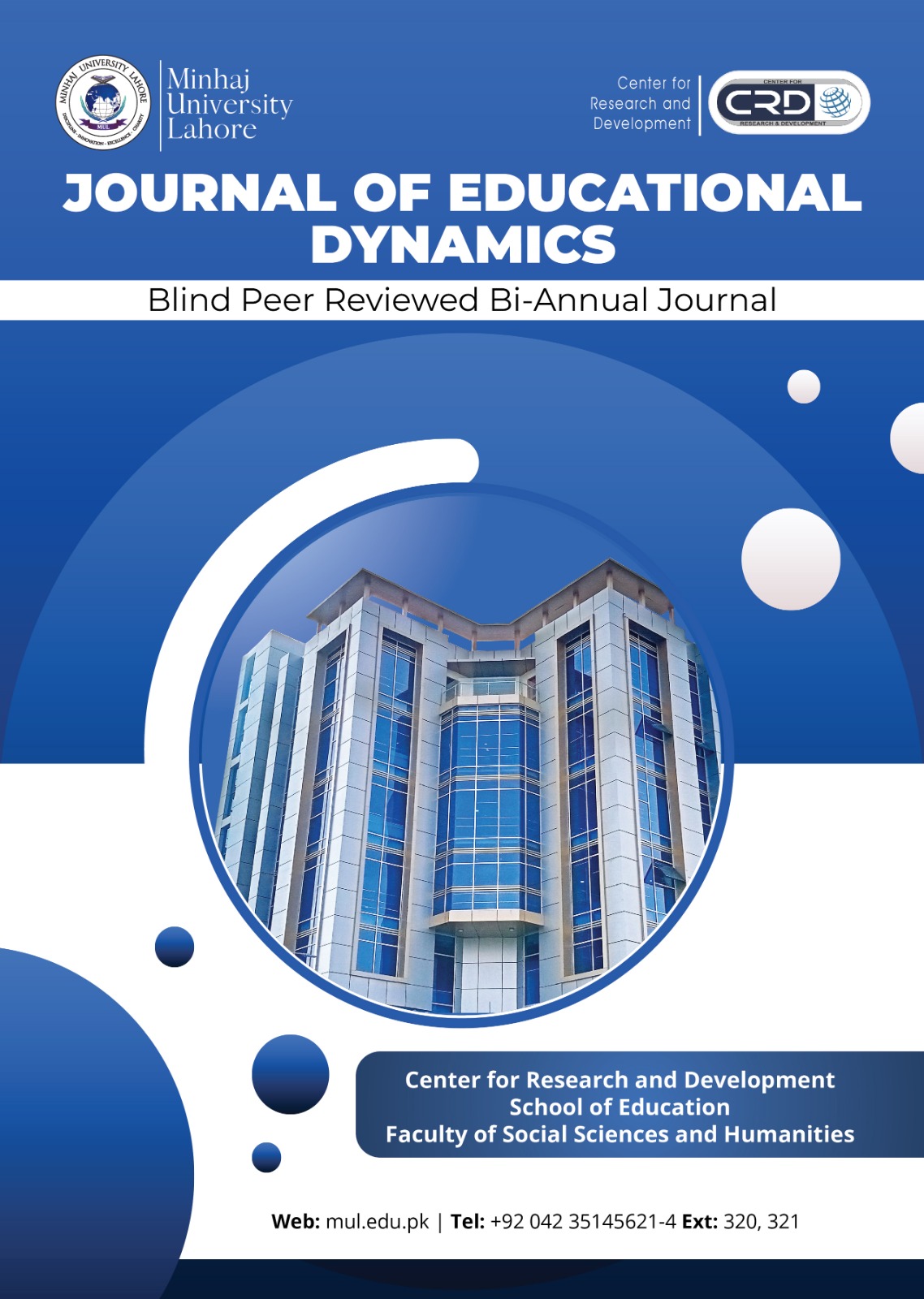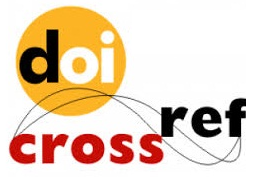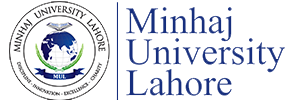Assessing the Effectiveness of STEM Activities in Enhancing Motivation Among Secondary School Students: Enhancing Technology Integration
DOI:
https://doi.org/10.58932/MULI0012Keywords:
STEM education, Motivation level, Secondary school levelAbstract
This study examines how STEM (science, technology, engineering, and mathematics) education affects students' motivation levels from the viewpoints of 10th graders in Sialkot and Faisalabad districts as well as secondary school teachers. The study recruited 400 students and 50 teachers and used quantitative analysis to evaluate variables like interest levels, learning orientation, autonomy, confidence, and overall motivation. To address the designed research questions a rating scale instrument was used to collect data. There were no discernible gender variations in teachers' and students' perceptions of how STEM education affected these motivating qualities, according to independent sample t-tests. According to both groups, STEM education improves motivation and related factors for both genders. These results imply that STEM education creates a fair learning environment and balances student passion and involvement. To maintain and improve student motivation, the study suggests providing equitable access to STEM opportunities and resources for all genders, as well as activities that foster confidence, student-centered learning strategies, and useful, entertaining STEM applications.
References
Agbejoye, S. J., & Oke, S. (2019). Class size and gender as determinant of students’ performance in electrical courses in colleges of education in Lagos state. International Journal of Business Tourism and Applied Sciences (IJBTS), 6(2), 199-220.
Bandura, A. (1997). Self-efficacy: The exercise of control. New York: Freeman.
Schunk, D. H., & Pajares, F. (2002). The development of academic self-efficacy. In A. Wigfield & J. S. Eccles (Eds.), Development of Achievement Motivation (pp. 15–31). San Diego, CA: Academic Press.
Bao, W. (2020). COVID‐19 and online teaching in higher education: A case study of Peking University. Human Behavior and Emerging Technologies, 2(2), 113-115.
Barker, B., Welch, G., & Wu, C. (2015). A model of factors contributing to STEM learning and career orientation. International Journal of Science Education, 37(7), 1067–1088. https://doi.org/10.1080/09500693.2015.1017863.
Blickenstaff, J. C. (2005). Women and science careers: Leaky pipeline or gender filter? Gender and Education, 17(4), 369–386. https://doi.org/10.1080/09540250500145072
Christensen, R., Knezek, G., & Tyler-Wood, T. (2015). Gender differences in high school student dispositions toward science, technology, engineering, and mathematics careers. Journal of Computers in Mathematics and Science Teaching, 34(4), 395–408.
De Roock, R. S., & Baildon, M. (2019). My skills future for students, STEM learning, and the design of neoliberal citizenship in Singapore. Cognition and Instruction, 37(3), 285–305. https://doi.org/10.1080/07370008.2019.1624545
Fan, S. C., & Yu, K. C. (2017). How an integrative STEM curriculum can benefit students in engineering design practices. International Journal of Technology and Design Education, 27(1), 107-129.
Gupta, R., Fraser, J., Rank, S. J., Brucker, J. L., & Flinner, K. (2019). Multi-site case studies about zoo and aquarium visitors’ perceptions of the STEM learning ecology. Visitor Studies, 22(2), 127–146. https://doi.org/10.1080/10645578.2019.1661737
Gupta, R., Voiklis, J., Rank, S. J., Dwyer, J. de la T., Fraser, J., Flinner, K., & Nock, K. (2020). Public perceptions of the STEM learning ecology–perspectives from a national sample in the US. International Journal of Science Education, 10(2), 112–126. https://doi.org/10.1080/21548455.2020.1719291
Harris, A., & De Bruin, L. R. (2017). Secondary school creativity, teacher practice and STEAM education: An international study. Journal of Educational Change, 19(2), 153- 179.
Kelly, M., Dowling, M., & Millar, M. (2018). The search for understanding: The role of paradigms. Nurse Researcher, 25(4), 9-13.
King, D. (2015). STEM learning through engineering design: fourth-grade students’ investigations in aerospace. International Journal of STEM Education, 2(1). https://doi.org/10.1186/s40594- 015-0027-7
Larkin, M., Shaw, R., & Flowers, P. (2019). Multi perspectival designs and processes in interpretative phenomenological analysis research. Qualitative Research in Psychology, 16(2), 182-198.
Li, H., Forbes, A., & Yang, W. (2021). Developing culturally and developmentally appropriate early STEM learning experiences. Early Education and Development 32(1), 1–6). https://doi.org/10.1080/10409289.2020.1833674
LópezLeiva, C., Roberts-Harris, D., & von Toll, E. (2016). Meaning making with motion is messy: developing a STEM learning community. Canadian Journal of Science, Mathematics and Technology Education, 16(2), 169–182. https://doi.org/10.1080/14926156.2016.1166293
Madani, R. A. (2019). Analysis of educational quality, a goal of education for all policy. Higher Education Studies, 9(1), 100-109.
Mallette, L., & Saldaña, J. (2019). Teaching qualitative data analysis through gaming. Qualitative Inquiry, 25(10), 1085-1090.
Margot, K. C., & Kettler, T. (2019). Teachers’ perception of STEM integration and education: A systematic literature review. International Journal of STEM Education, 6(1), 1–16. https://doi.org/10.1186/s40594-018-0151-2
Maltese, A. V., & Tai, R. H. (2011). Pipeline persistence: Examining the association of educational experiences with earned degrees in STEM among U.S. students. Science Education, 95(5), 877–907. https://doi.org/10.1002/sce.20441
Morrissey, K., Heimlich, J. E., & Schatz, D. (2020). Redefining professionalism for the informal STEM learning field. Museum Management and Curatorship, https://doi.org/10.1080/09647775.2020.1803109
Nugent, G., Barker, B., Welch, G., Grandgenett, N., Wu, C. R., & Nelson, C. (2015). A model of factors contributing to STEM learning and career orientation. International Journal of Science Education, 37(7), 1067–1088. https://doi.org/10.1080/09500693.2015.1017863
Pintrich, P. R. (2003). A motivational science perspective on the role of student motivation in learning and teaching contexts. Journal of Educational Psychology, 95(4), 667–686.
Rahm, J. (2019). The re-storying of STEM learning through the lens of multiples. Cognition and Instruction 37(3), 408–413. https://doi.org/10.1080/07370008.2019.1624550
Renninger, K. A., & Hidi, S. (2016). The power of interest for motivation and engagement. Routledge.
Roberts, T. (2018). Students’ perceptions of STEM learning after participating in a summer informal learning experience. Stem Education Journal, 12(3), 19-30. https://stemeducationjournal.springeropen.com/articles/10.1186/s40594-018-0133-4
Sahin, A. (2013). STEM clubs and science fair competitions: Effects on post-secondary matriculation. Journal of STEM Education: Innovations and Research, 14(1), 5–11.
Shin, J., Sutherland, L. M., Shin, S. Q., Conroy, M. A., & Sosniak, L. A. (2021). Gender differences in motivational beliefs in STEM and the role of learning environments. Contemporary Educational Psychology, 65, 101947. https://doi.org/10.1016/j.cedpsych.2021.101947
Stoet, G., & Geary, D. C. (2018). The gender-equality paradox in science, technology, engineering, and mathematics education. Psychological Science, 29(4), 581–593. https://doi.org/10.1177/0956797617741719
Struyf, A., De Loof, H., Boeve-de Pauw, J., & Van Petegem, P. (2019). Students’ engagement in different STEM learning environments: integrated STEM education as promising practice? International Journal of Science Education, 41(10), 1387–1407. https://doi.org/10.1080/09500693.2019.1607983
Wang, M. T., & Degol, J. L. (2017). Gender gap in STEM: Current knowledge, implications for practice, policy, and future directions. Educational Psychology Review, 29(1), 119–140. https://doi.org/10.1007/s10648-015-9355-x
Yelland, N., & Waghorn, E. (2020). STEM learning ecologies: collaborative pedagogies for supporting transitions to school. International Journal of Early Years Education, 18(6), 211-232. https://doi.org/10.1080/09669760.2020.1863193








